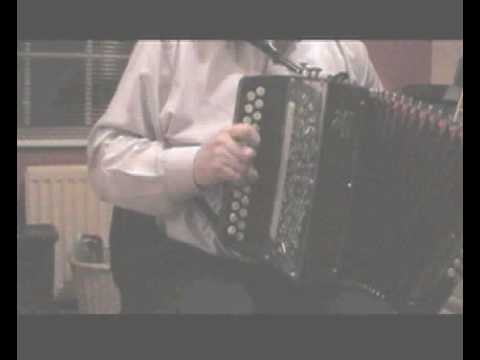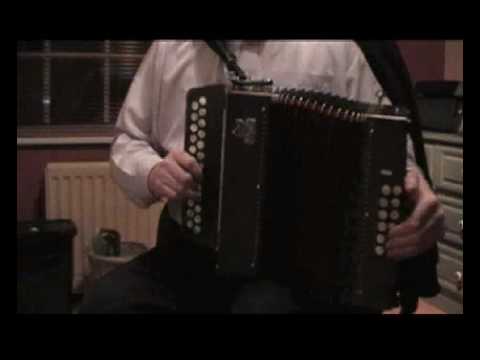no, it is not true that “most clare players players play c#/d.” no, it is not true that “most players play c#/d.” yes, it IS true, that if you are going to be really good, you are going to be able to play both.
why? because a really good, serious box player as opposed to a passable one, must play well in all keys used in irish trad. somebody like billy mccomiskey could play along with the cooley record in its original e-flat register without batting an eyelash, and all he would lack would be the e-flat basses. sure, they usually record or perform in “optimal” keys for their box, and to do this they change boxes or change keys to hit fingerings they like, but really good players CAN play well in all of them. the really serious players have boxes in different key tunings so they can pick which one has the fingering they like best for that key.
so, for example, if, say, you happened to be a b/c player (like me  ) who loves the low “flat” keys such as C majorish, F, or g minor/mixylish, so loved by us east clare/east galway devotees…you are gonna be a c#/d player whether you meant to be or not. why? tunes in these keys on b/c are fingered exactly as you finger them in D majorish, G , and a-minor/mixylish, on the c#/d. so…when b/c players play a D tune in C or a G tune in F, or an a-minor/mix/modalish tune in g-minor/mix/modalish, they are in fact playing C#/D fingering, capeesh? or other way round, when a c#/d player wants to play flat, they grab a b/c box and play their D tunes in C, their G tunes in F, and their a-minorish tunes in g-minorish.
) who loves the low “flat” keys such as C majorish, F, or g minor/mixylish, so loved by us east clare/east galway devotees…you are gonna be a c#/d player whether you meant to be or not. why? tunes in these keys on b/c are fingered exactly as you finger them in D majorish, G , and a-minor/mixylish, on the c#/d. so…when b/c players play a D tune in C or a G tune in F, or an a-minor/mix/modalish tune in g-minor/mix/modalish, they are in fact playing C#/D fingering, capeesh? or other way round, when a c#/d player wants to play flat, they grab a b/c box and play their D tunes in C, their G tunes in F, and their a-minorish tunes in g-minorish.
on the “open hearth” duo cd by andrew & mary mac, for example, andrew is playing most of those tracks on a b/c box using his c#/d fingering. sharon shannon records plenty of flat tunes playing on the C row of the b/c box she keeps for playing flat, see?
i am actually right now in the process of seriously expanding my C, F & G minor repertoire partly to play the low keys that i love, and partly because…ok, i, too have a little C#/D fetish.  my d minor on b/c is the same fingering as a c#/d player’s e minor, dig? if i learn pat o’connor’s “green mountain” cd, or the older tulla ceili records, much of which are in C & F, i’m gonna be playing it all c#/d style. same with christy mcnamara’s record, “the house i was reared in.” christy is one of the many clare players who play b/c. on that record he is playing mostly in C, F, and g minor------thus, c#/d fingering. josephine, who also is a lovely clare b/c player, does plenty of tunes in C & F, as does johnny mccarthy of ennis, a gorgeous clare b/c player whose cd “solo run” is full of flat tunes. mary rafferty is a b/c player who does all that ravishing east galway stuff on her b/c.
my d minor on b/c is the same fingering as a c#/d player’s e minor, dig? if i learn pat o’connor’s “green mountain” cd, or the older tulla ceili records, much of which are in C & F, i’m gonna be playing it all c#/d style. same with christy mcnamara’s record, “the house i was reared in.” christy is one of the many clare players who play b/c. on that record he is playing mostly in C, F, and g minor------thus, c#/d fingering. josephine, who also is a lovely clare b/c player, does plenty of tunes in C & F, as does johnny mccarthy of ennis, a gorgeous clare b/c player whose cd “solo run” is full of flat tunes. mary rafferty is a b/c player who does all that ravishing east galway stuff on her b/c.
conversely, c#/d players are also often using fingerings that b/c players use. when c#/d players play e-majorish tunes, they are using the exact same fingering b/c players use for D-majorish tunes. a c#/d player’s a minor/modal/mixyl-ish fingering is the same as a b/c player’s g minor/modal/mixyl-ish figering.
in fact, i’m starting to believe that except for majorish tunes in the key with the same name as the scale of the row you are playing on (D majorish for c#/d, C majorish for b/c) the whole alleged polarity is propaganda. bottom line, the only time the c#/d players are getting the “true” press-draw feel in its 100% pure, unadulterated press-draw form, are D majorish tunes on the D row, or C majori-ish on the C row of the b/c. (the minorish/modalish/mixylish tunes in the row key are not discernibly more “press-draw” than on the b/c.) Coming in second would be major-ish tunes in the key of the fifth to the name-row key. so A major-ish for the c#/d, G major-ish for the b/c, yes, they too kinda have the press-draw feel. all the other keys on c#/d don’t have any magic press-draw sound. it is no coincidence that when you think of the iconic c#/d recordings that allegedly have “the” sound, the tunes are nearly all in name-row majorish keys. i.e., the “cooley” record, where nearly all the tunes are in e-flat majorish on the e-flat row of a d/d# box. or the sliabh luachra stuff in D & A.
if you’re really serious, you want more than one box in different keys, because you don’t have enough basses to play in all of the keys. from an expressive-freedom standpoint, the whole thing can be a major pain in the keester.
which is why playing the concertina to me felt like a bird flying out of the cage. and which is additionally why i am also getting seriously addicted to the continental chromatic button accordion. 
AND, which is ALSO why tony macmahon recently stated in an interview, “F*** THE TWO-ROW DIATONIC ACCORDION!!!”

in sum, here are some lovely clips of a gent playing cooley-style on an e-flat box. if i played these tunes in C and F and g-minor on my b/c box, they would finger just the same  :
:



